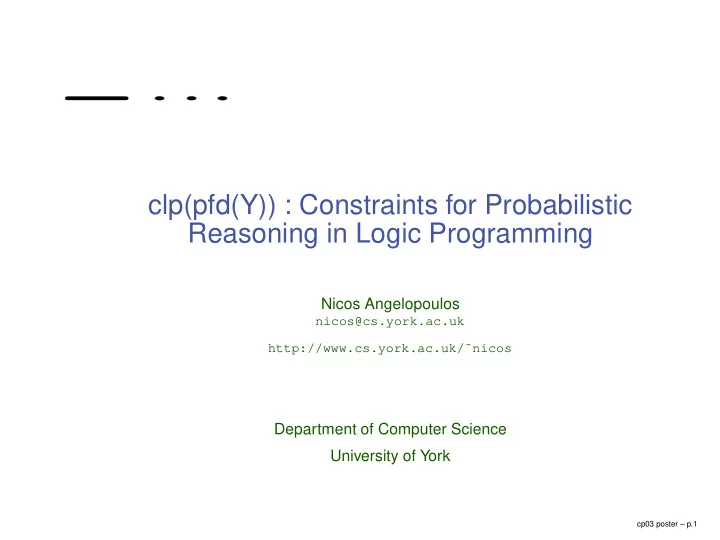

clp(pfd(Y)) : Constraints for Probabilistic Reasoning in Logic Programming Nicos Angelopoulos nicos@cs.york.ac.uk http://www.cs.york.ac.uk/˜nicos Department of Computer Science University of York cp03 poster – p.1
probabilistic finite domains For discrete graphical models: extend the idea of finite domains to admit distributions. from X in { a, b } (i.e. X = a or X = b ) to [ p ( X = a ) + p ( X = b ) ] = 1 cp03 poster – p.2
clp(pfd(Y)) framework For finite domain variable V in { v 1 , . . . , v n } and specific probabilistic inference algorithm Y , clp(pfd(Y)) computes ψ S ( V ) = { ( v 1 , π 1 ) , ( v 2 , π 2 ) , . . . , ( v n , π n ) } cp03 poster – p.3
clp(pfd(Y)) framework E i the probabilistic variables in E , e vector, one element from each variable P S ( E i = e i ) = π i E/e predicate E , variables replaced by e . � P S ( E ) = P ( E | P ∪ S ) = P S ( E/e ) ∀ e P∪S⊢ E/e � � = P S ( E i = e i ) ∀ e i P∪S⊢ E/e cp03 poster – p.4
Graphical Models integration Execution, assembles the graphical model in the store according to program and query. Existing algorithms can be used for probabilistic inference on the model present in the store. Similarities in constraint propagation and probability propagation algorithms suggest interleaving algorithms maybe possible. cp03 poster – p.5
clp(pfd(Y)) example For example, for program P 1 : lucky( iv, hd). lucky( v, hd). lucky( vi, hd). store S 1 with variables D and C , with ψ S 1 ( D ) = { ( i, 1 / 6) , ( ii, 1 / 6) , ( iii, 1 / 6) , ( iv, 1 / 6) , ( v, 1 / 6) , ( vi, 1 / 6) } ψ S 1 ( C ) = { ( hd, 1 / 2) , ( tl, 1 / 2) } . The probability of a lucky combination is P S 1 ( lucky ( D, C )) = 1 / 4 . cp03 poster – p.6
clp(pfd(bn)) example A B C A = y A = n A = y A = n B = y 0.80 0.10 C = y 0.60 0.90 B = n 0.20 0.90 C = n 0.40 0.10 cp03 poster – p.7
clp(pfd(bn)) program example_bn( A, B, C ) :- cpt(A,[],[y,n]), cpt(B,[A],[(y,y,0.8),(y,n,0.2), (n,y,0.1),(n,n,0.9)]), cpt(C,[A],[(y,y,0.6),(y,n,0.4), (n,y,0.9),(n,n,0.1)]). cp03 poster – p.8
clp(pfd(bn)) query ?- example_bn(X,Y,Z), evidence(X,[(y,0.8),(n,0.2)], Zy is p(Z = y). Zy = 0.66 cp03 poster – p.9
interactions gR ? CLP Graphical Models Inference Constraints & Logic engine Store Learning cp03 poster – p.10
clp(pfd(c)) Probabilistic variables are declared with V ∼ φ V ( Fd, Args ) Probability ascribing function φ V and finite domain Fd are kept separately. Variable example Heat ∼ finite _ geometric ([ l, m, h ] , [2]) finite geometric distribution with deterioration factor is 2 . In the absence of other information ψ ∅ ( Heat ) = { ( l, 4 / 7)( m, 2 / 7) , ( h, 1 / 7) } cp03 poster – p.11
clp(pfd(c)) conditionals Conditional C D 1 : π 1 ⊕ . . . ⊕ D m : π m Q Each D i is a predicate and all should share a single probabilistic variable V . Q is a predicate not containing V , and � 0 ≤ π i ≤ 1 , π i = 1 i V ’s distribution is altered as a result of C being added to the store. cp03 poster – p.12
clp(pfd(c)) subspaces C partitions the space to weighted subspaces within which different events hold. Inference uses these partitions and the application of functions to compute updated probability distributions for the conditioned variables. cp03 poster – p.13
clp(pfd(Y)) Caesar’s encodings To illustrate benefits from the additional information in clp(pfd(Y)) when compared to clp(fd) we juxtapose performances of respective programs for a simple Caesar encoding scheme. The two programs are identical bar: (i) distribution over domains in clp(pfd(c)) based on the formula | freq ( E i ) − freq ( D i ) | � k | freq ( E i ) − freq ( D k ) | and (ii) labelling in clp(pfd(c)) uses a best-first algorithm. cp03 poster – p.14
clp(pfd(Y)) vs. clp(fd) time comparison 1200 clp(FD) pfd 1000 800 600 400 200 0 0 20 40 60 80 100 Run on SICStus 3.8 http://www.cs.york.ac.uk/ ˜ nicos/sware/pfds http://www.doc.ic.ac.uk/ ˜ nicos/sware/pfds cp03 poster – p.15
Recommend
More recommend